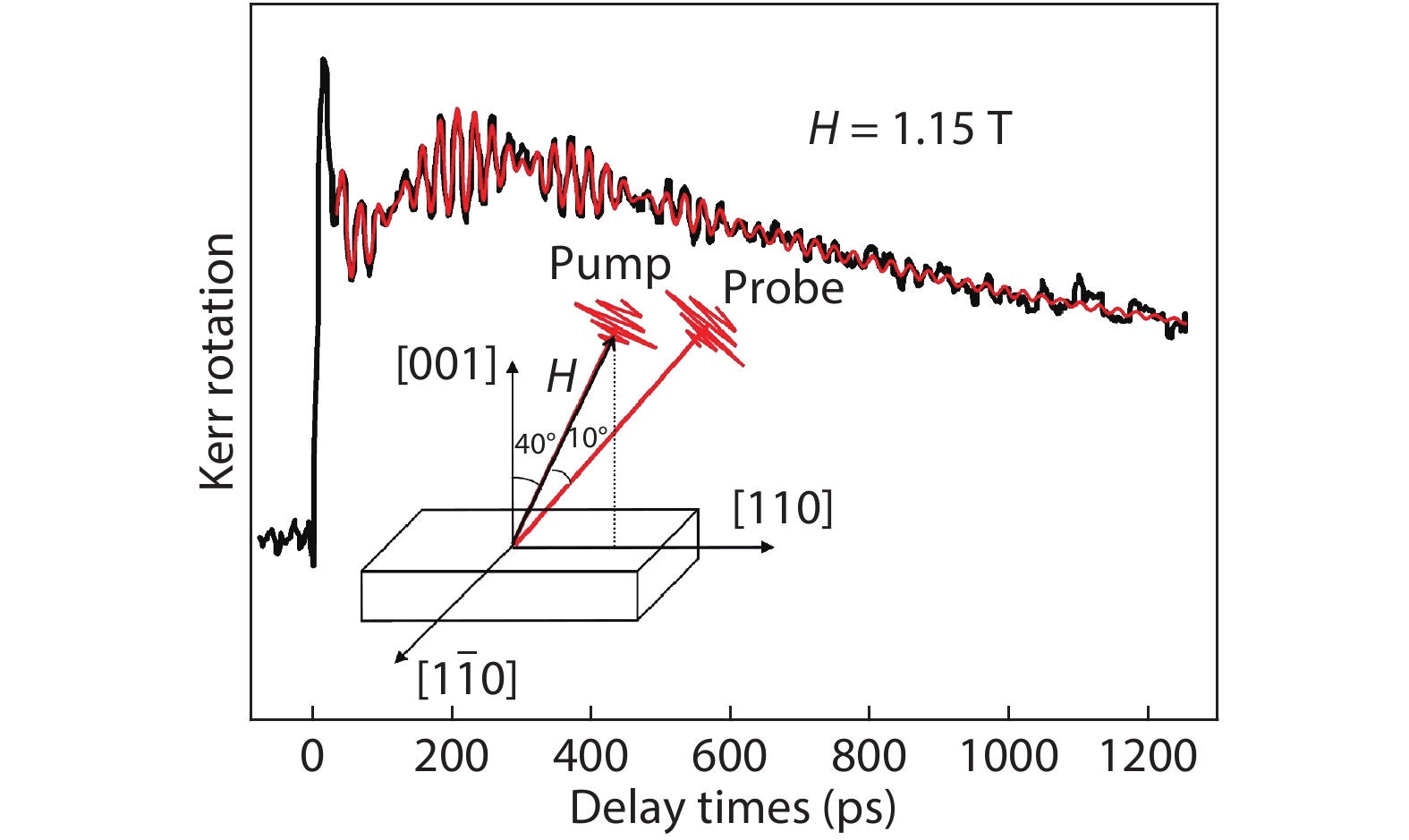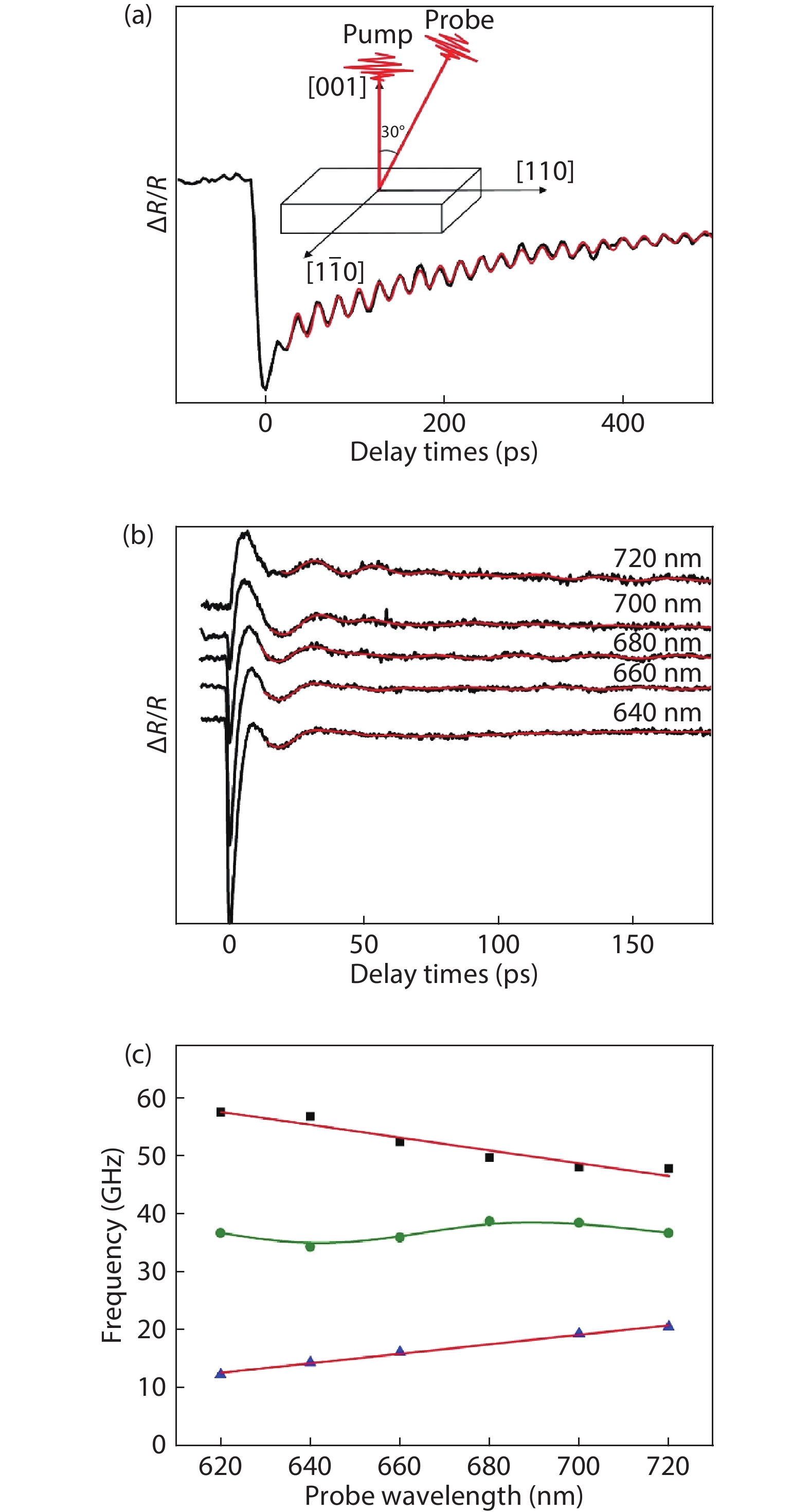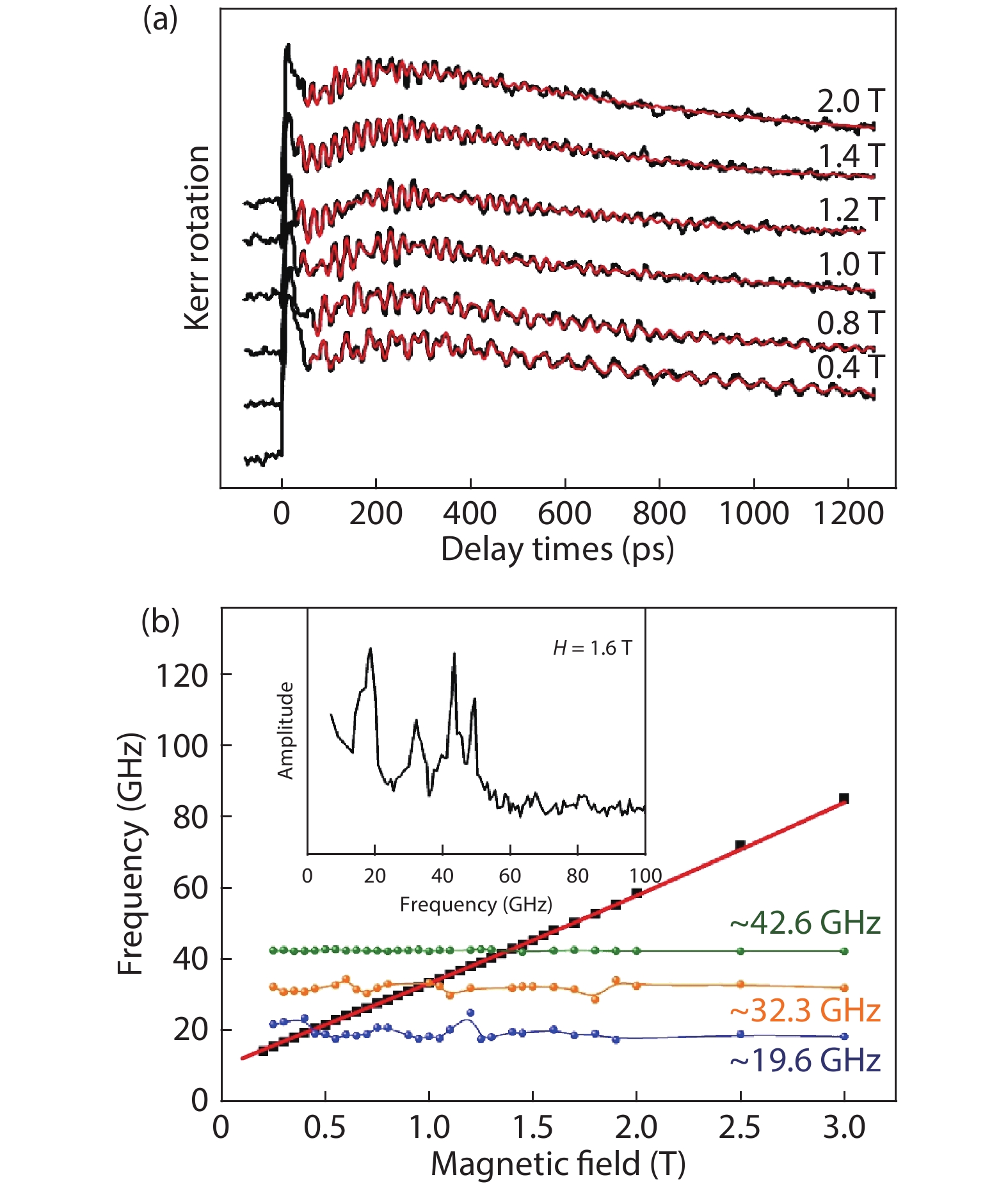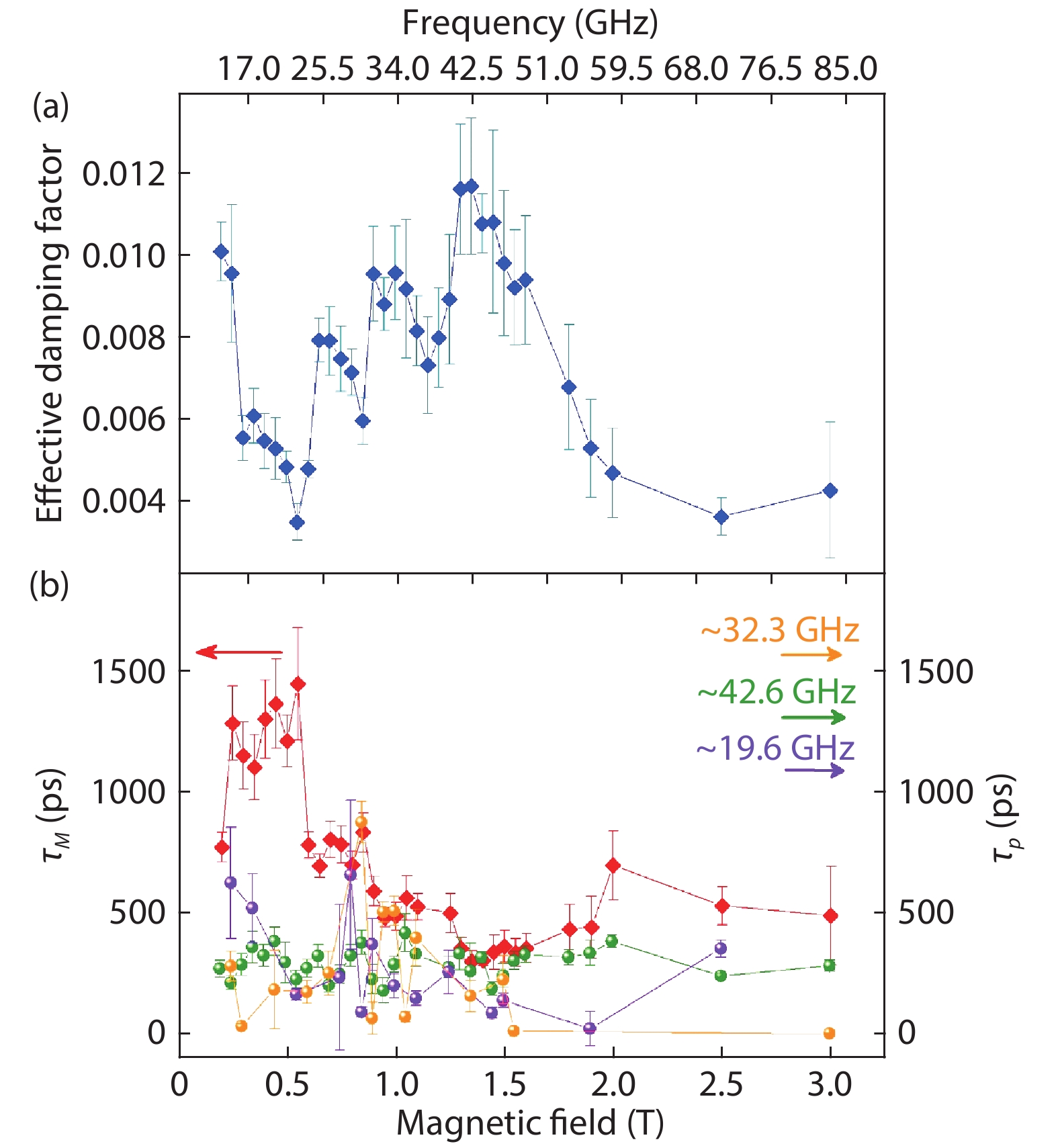| Citation: |
Lin Song, Wei Yan, Hailong Wang, Jianhua Zhao, Xinhui Zhang. Resonant enhancement of magnetic damping driven by coherent acoustic phonons in thin Co2FeAl film epitaxied on GaAs[J]. Journal of Semiconductors, 2021, 42(3): 032501. doi: 10.1088/1674-4926/42/3/032501
****
L Song, W Yan, H L Wang, J H Zhao, X H Zhang, Resonant enhancement of magnetic damping driven by coherent acoustic phonons in thin Co2FeAl film epitaxied on GaAs[J]. J. Semicond., 2021, 42(3): 032501. doi: 10.1088/1674-4926/42/3/032501.
|
Resonant enhancement of magnetic damping driven by coherent acoustic phonons in thin Co2FeAl film epitaxied on GaAs
DOI: 10.1088/1674-4926/42/3/032501
More Information
-
Abstract
The magnetic dynamics of a thin Co2FeAl film epitaxially grown on GaAs substrate was investigated using the time-resolved magneto-optical Kerr measurement under an out-of-plane external field. The intrinsic magnetic damping constant, which should do not vary with the external magnetic field, exhibits an abnormal huge increase when the precession frequency is tuned to be resonant with that of the coherent longitudinal acoustic phonon in the Co2FeAl/GaAs heterostructure. The experimental finding is suggested to result from the strong coherent energy transfer from spins to acoustic phonons via magnetoelastic effect under a resonant coupling condition, which leads to a huge energy dissipation of spins and a greatly enhanced magnetic damping in Co2FeAl. Our experimental findings provide an experimental evidence of spin pumping-like effect driven by propagating acoustic phonons via magnetoelastic effect, suggesting an alternative approach to the possible long-range spin manipulation via coherent acoustic waves. -
References
[1] Žutić I, Fabian J, Sarma S D. Spintronics: Fundamentals and applications. Rev Mod Phys, 2004, 76, 323 doi: 10.1103/RevModPhys.76.323[2] Brataas A, Kent A D, Ohno H. Current-induced torques in magnetic materials. Nat Mater, 2012, 11, 372 doi: 10.1038/nmat3311[3] de Groot R A, Mueller F M, van Engen P G, et al. New class of materials: Half-metallic ferromagnets. Phys Rev Lett, 1983, 50, 2024 doi: 10.1103/PhysRevLett.50.2024[4] Kübler J, Williams A R, Sommers C B. Formation and coupling of magnetic moments in Heusler alloys. Phys Rev B, 1983, 28, 1745 doi: 10.1103/PhysRevB.28.1745[5] Ishida S, Fujii S, Kashiwagi S, et al. Search for Half-Metallic compounds in Co2MnZ (Z = IIIb, IVb, Vb Element). J Phys Soc Jpn, 1995, 64, 2152 doi: 10.1143/JPSJ.64.2152[6] Picozzi S, Continenza A, Freeman A J. Co2MnX (X = Si, Ge, Sn) Heusler compounds: An ab initio study of their structural, electronic, and magnetic properties at zero and elevated pressure. Phys Rev B, 2002, 66, 094421 doi: 10.1103/PhysRevB.66.094421[7] Webster P J. Magnetic and chemical order in Heusler alloys containing cobalt and manganese. J Phys Chem Solids, 1971, 32, 1221 doi: 10.1016/S0022-3697(71)80180-4[8] Mizukami S, Watanabe D, Oogane M, et al. Low damping constant for Co2FeAl Heusler alloy films and its correlation with density of states. J Appl Phys, 2009, 105, 07D306 doi: 10.1063/1.3067607[9] Sukegawa H, Wen Z, Kondou K, et al. Spin-transfer switching in full-Heusler Co2FeAl-based magnetic tunnel junctions. Appl Phys Lett, 2012, 100, 182403 doi: 10.1063/1.4710521[10] Kikuchi R. On the minimum of magnetization reversal time. J Appl Phys, 1956, 27, 1352 doi: 10.1063/1.1722262[11] Lee K, Kang S H. Development of embedded STT-MRAM for mobile system-on-chips. IEEE Trans Magn, 2011, 47, 131 doi: 10.1109/TMAG.2010.2075920[12] Kamberský V. Spin-orbital Gilbert damping in common magnetic metals. Phys Rev B, 2007, 76, 134416 doi: 10.1103/PhysRevB.76.134416[13] Hickey M C, Moodera J S. Origin of intrinsic Gilbert damping. Phys Rev Lett, 2009, 102, 137601 doi: 10.1103/PhysRevLett.102.137601[14] He P, Ma X, Zhang J W, et al. Quadratic scaling of intrinsic Gilbert damping with spin-orbital coupling in L10 FePdPt films: Experiments and Ab initio calculations. Phys Rev Lett, 2013, 110, 077203 doi: 10.1103/PhysRevLett.110.077203[15] Yuan H C, Nie S H, Ma T P, et al. Different temperature scaling of strain induced magneto-crystalline anisotropy and Gilbert damping in Co2FeAl film epitaxied on GaAs. Appl Phys Lett, 2014, 105, 072413 doi: 10.1063/1.4893949[16] Liu Y, Shelford L R, Kruglyak V V, et al. Optically induced magnetization dynamics and variation of damping parameter in epitaxial Co2MnSi Heusler alloy films. Phys Rev B, 2010, 81, 094402 doi: 10.1103/PhysRevB.81.094402[17] Woltersdorf G, Heinrich B. Two-magnon scattering in a self-assembled nanoscale network of misfit dislocations. Phys Rev B, 2004, 69, 184417 doi: 10.1103/PhysRevB.69.184417[18] Tserkovnyak Y, Brataas A, Bauer G E W. Enhanced Gilbert damping in thin ferromagnetic films. Phys Rev Lett, 2002, 88, 117601 doi: 10.1103/PhysRevLett.88.117601[19] Tserkovnyak Y, Brataas A, Bauer G E W. Spin pumping and magnetization dynamics metallic multilayers. Phys Rev B, 2002, 66, 224403 doi: 10.1103/PhysRevB.66.224403[20] Fukuma Y, Wang L, Idzuchi H, et al. Giant enhancement of spin accumulation and long-distance spin precession in metallic lateral spin valves. Nat Mater, 2011, 10, 527 doi: 10.1038/nmat3046[21] Weiler M, Dreher L, Heeg C, et al. Elastically driven ferromagnetic resonance in nickel thin films. Phys Rev Lett, 2011, 106, 117601 doi: 10.1103/PhysRevLett.106.117601[22] Weiler M, Huebl H, Goerg F S, et al. Spin pumping with coherent elastic waves. Phys Rev Lett, 2012, 108, 176601 doi: 10.1103/PhysRevLett.108.176601[23] Uchida K, An T, Kajiwara Y, et al. Surface-acoustic-wave-driven spin pumping in Y3Fe5O12/Pt hybrid structure. Appl Phys Lett, 2011, 99, 212501 doi: 10.1063/1.3662032[24] Li X, Labanowski D, Salahuddin S, et al. Spin wave generation by surface acoustic waves. J Appl Phys, 2107, 122, 043904 doi: 10.1063/1.4996102[25] Uchida K, Adachi H, An T, et al. Long-range spin Seebeck effect and acoustic spin pumping. Nat Mater, 2011, 10, 737 doi: 10.1038/nmat3099[26] Jaworski C M, Yang J, Mack S, et al. Spin-Seebeck effect: A phonon driven spin distribution. Phys Rev Lett, 2011, 106, 186601 doi: 10.1103/PhysRevLett.106.186601[27] Adachi H, Uchida K, Saitoh E, et al. Gigantic enhancement of spin Seebeck effect by phonon drag. Appl Phys Lett, 2010, 97, 252506 doi: 10.1063/1.3529944[28] Uchida K, Xiao J, Adachi H, et al. Spin Seebeck insulator. Nat Mater, 2010, 9, 894 doi: 10.1038/nmat2856[29] Korenev V L, Salewski M, Akimov I A, et al. Long-range p-d exchange interaction in a ferromagnet-semiconductor hybrid structure. Nat Phys, 2015, 12, 85 doi: 10.1038/nphys3497[30] Streib S, Keshtgar H, Bauer G E W. Damping of magnetization dynamics by phonon pumping. Phys Rev Lett, 2018, 121, 027202 doi: 10.1103/PhysRevLett.121.027202[31] An K, Litvinenko A N, Kohno R, et al. Coherent long-range transfer of angular momentum between magnon Kittel modes by phonons. Phys Rev B, 2020, 101, 060407(R doi: 10.1103/PhysRevB.101.060407[32] Ruckriegel A, Duine R A. Long-range phonon spin transport in ferromagnet/nonmagnetic insulator heterostructures. Phys Rev Lett, 2020, 124, 117201 doi: 10.1103/PhysRevLett.124.117201[33] Devos A, Côte R, Caruyer G, et al. A different way of performing picosecond ultrasonic measurements in thin transparent films based on laser-wavelength effects. Appl Phys Lett, 2005, 86, 211903 doi: 10.1063/1.1929869[34] Liu W, Xie W, Guo W, et al. Coherent scattering of exciton polaritons and acoustic phonons in a ZnO single crystal. Phys Rev B, 2014, 89, 201201 doi: 10.1103/PhysRevB.89.201201[35] Suhl H. Ferromagnetic resonance in Nickel ferrite between one and two kilomegacycles. Phys Rev, 1954, 97, 555 doi: 10.1103/PhysRev.97.555.2[36] Qiao S, Nie S, Zhao J, et al. Temperature dependent magnetic anisotropy of epitaxial Co2FeAl films grown on GaAs. J Appl Phys, 2015, 117, 093904 doi: 10.1063/1.4913949[37] Qiao S, Nie S, Zhao J, et al. The thickness-dependent dynamic magnetic property of Co2FeAl films grown by molecular beam epitaxy. Appl Phys Lett, 2014, 105, 172406 doi: 10.1063/1.4900792[38] Miller J K, Qi J, Xu Y, et al. Near-bandgap wavelength dependence of long-lived traveling coherent longitudinal acoustic phonons in GaSb-GaAs heterostructures. Phys Rev B, 2006, 74, 113313 doi: 10.1103/PhysRevB.74.113313[39] Matsuda O, Wright O B, Hurley D H, et al. Coherent shear phonon generation and detection with ultrashort optical pulses. Phys Rev Lett, 2004, 93, 095501 doi: 10.1103/PhysRevLett.93.095501[40] Yan W, Wang H, Zhao J, et al. Ultrafast optical probe of coherent acoustic phonons in Co2MnAl Heusler film. Chin Phys B, 2017, 26, 016802 doi: 10.1088/1674-1056/26/1/016802[41] Thomsen C, Strait J, Vardeny Z, et al. Coherent phonon generation and detection by picosecond light pulses. Phys Rev Lett, 1984, 53, 989 doi: 10.1103/PhysRevLett.53.989[42] Thomen C, Grahn H T, Marisetal H J, et al. Surface generation and detection of phonons by picosecond light pulses. Phys Rev B, 1986, 34, 4129 doi: 10.1103/PhysRevB.34.4129[43] Lin H N, Stoner R J, Maris H J, et al. Phonon attenuation and velocity measurements in transparent materials by picosecond acoustic interferometry. J Appl Phys, 1991, 69, 3816 doi: 10.1063/1.348958[44] Aspnes D E, Kelso S M, Logan R A, et al. Optical properties of AlxGa1−xAs. J Appl Phys, 1986, 60, 754 doi: 10.1063/1.337426[45] Blakemore J S. Semiconducting and other major properties of gallium arsenide. J Appl Phys, 1982, 53, R123 doi: 10.1063/1.331665[46] Popović Z V, Spitzer J, Ruf T, et al. Folded acoustic phonons in GaAs/AlAs corrugated superlattices grown along the [311] direction. Phys Rev B, 1993, 48, 1659 doi: 10.1103/PhysRevB.48.1659[47] Saito T, Matsuda O, Wright O B. Picosecond acoustic phonon pulse generation in nickel and chromium. Phys Rev B, 2003, 67, 205421 doi: 10.1103/PhysRevB.67.205421[48] Chikazumi S. Physics of Ferromagnetism. New York: Oxford University Press, 1997[49] Bömmel H, Dransfield K. Excitation of hypersonic waves by ferromagnetic resonance. Phys Rev Lett, 1959, 3, 83 doi: 10.1103/PhysRevLett.3.83[50] Schlomann E. Generation of phonons in high-power ferromagnetic resonance experiments. J Appl Phys, 1960, 31, 1647 doi: 10.1063/1.1735909[51] Seavey M H. Microwave phonon generation by thin magnetic films. IEEE Trans Ultrason Eng, 1963, 10(1), 49 doi: 10.1109/T-UE.1963.29301[52] Ignatchenko V A, Kuzmin E V. Magnetoelastic interaction in a thin magnetic film. J Appl Phys, 1968, 39, 494 doi: 10.1063/1.2163499[53] Seavey M H. Boundary-value problem for magnetoelastic waves in a metallic film. Phys Rev, 1968, 170, 560 doi: 10.1103/PhysRev.170.560[54] Yamaguchi S, Tahara T. Coherent acoustic phonons in a thin gold film probed by femtosecond surface plasmon resonance. J Raman Spectrosc, 2008, 39, 1703 doi: 10.1002/jrs.2078[55] Liu Y, Shelford L R, Kruglyak V V, et al. Ultrafast optical modification of magnetic anisotropy and stimulated precession in an epitaxial Co2MnAl thin film. J Appl Phys, 2007, 101, 09C106 doi: 10.1063/1.2711702[56] Qiao S, Nie S, Zhao J, et al. Magnetic and Gilbert damping properties of L21-Co2FeAl film grown by molecular beam epitaxy. Appl Phys Lett, 2013, 103, 152402 doi: 10.1063/1.4824654[57] Li T, Yan W, Zhang X, et al. Off-stoichiometry effect on magnetic damping in thin films of Heusler alloy Co2MnSi. Phys Rev B, 2020, 101, 174410 doi: 10.1103/PhysRevB.101.174410[58] McMichael R D, Stiles M D, Chen P J, et al. Ferromagnetic resonance linewidth in thin films coupled to NiO. J Appl Phys, 1998, 83, 7037 doi: 10.1063/1.367725[59] Landeros P, Arias R E, Mills D L. Two magnon scattering in ultrathin ferromagnets: The case where the magnetization is out of plane. Phys Rev B, 2008, 77, 214405 doi: 10.1103/PhysRevB.77.214405[60] Scherbakov A V, Salasyuk A S, Akimov A V, et al. Coherent magnetization precession in ferromagnetic (Ga, Mn)As induced by picosecond acoustic pulses. Phys Rev Lett, 2010, 105, 117204 doi: 10.1103/PhysRevLett.105.117204[61] Kim J W, Vomir M, Bigot J Y. Ultrafast magnetoacoustics in nickel films. Phys Rev Lett, 2012, 109, 166601 doi: 10.1103/PhysRevLett.109.166601[62] Hashimoto Y, Bossini D, Johansen T H, et al. Frequency and wavenumber selective excitation of spin waves through coherent energy transfer from elastic waves. Phys Rev B, 2018, 97, 140404(R doi: 10.1103/PhysRevB.97.140404[63] Garanin D A, Chudnovsky E M. Angular momentum in spin-phonon processes. Phys Rev B, 2015, 92, 024421 doi: 10.1103/PhysRevB.92.024421[64] Holanda J, Maior D S, Azevodo A, et al. Detecting the phonon spin in magnonphonon conversion experiments. Nat Phys, 2018, 14, 500 doi: 10.1038/s41567-018-0079-y[65] Nakane J J, Kohno H. Angular momentum of phonons and its application to single-spin relaxation. Phys Rev B, 2018, 97, 174403 doi: 10.1103/PhysRevB.97.174403[66] Tucker J W, Rampton V W. Microwave ultrasonics in solid state physics. Amsterdam: North-Holland, 1972.[67] Kittel C. Interaction of spin waves and ultrasonic waves in ferromagnetic crystals. Phys Rev, 1958, 110, 836 doi: 10.1103/PhysRev.110.836 -
Proportional views






 DownLoad:
DownLoad:

















